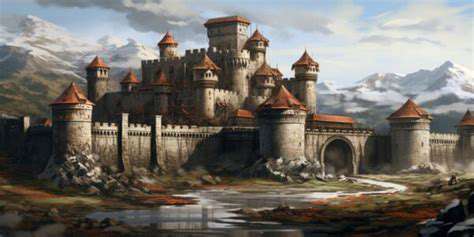Exploring Medieval Castles in Europe [Historical Tour]
The shift from wood to stone marked a quantum leap in defensive architecture. These imposing structures weren't just fortresses; they were bold statements of royal power and territorial dominance. Building them required staggering resources, skilled labor, and meticulous planning - all testaments to the wealth and influence of medieval nobility.
Castle designs varied dramatically based on local needs and available resources. Some featured elaborate central keeps, while others emphasized formidable perimeter walls and gatehouses. Advanced defensive elements like crenellations and machicolations gave defenders critical advantages, demonstrating the remarkable ingenuity of medieval military architects.
The Role of Geography in Castle Design
Location was everything in medieval castle construction. Strategic placement near rivers, atop hills, or along valleys dramatically enhanced defensive capabilities. Elevated positions offered superior visibility and defensive advantages, while waterways served as natural barriers. Medieval builders possessed an acute understanding of terrain that informed every aspect of their designs.
Beyond defense, castle locations reflected political realities. They often guarded vital trade routes, river crossings, or fertile lands, serving as both practical strongholds and powerful symbols of control. This intricate relationship between landscape and architecture resulted in unique fortresses tailored to their specific environments.
Life Within the Walls: Everyday Life in a Medieval Castle
Behind the battle-scarred walls, castles buzzed with complex social dynamics and daily routines. These were microcosms of medieval society, housing nobility, soldiers, servants, and craftsmen in carefully defined hierarchies. Life revolved around two primary concerns: maintaining the household and defending the territory.
Castles functioned as self-contained communities with kitchens, workshops, and living quarters. Each resident, from lord to lowliest servant, played a vital role in the castle's operation. Understanding this intricate social structure provides invaluable insights into medieval life beyond the romanticized images of knights and battles.
The Legacy of Medieval Fortifications
From simple earthworks to towering stone citadels, medieval fortifications left an indelible mark on history. Their architectural brilliance continues to inspire awe centuries later. These structures embodied power, security, and artistic achievement, showcasing medieval society's ingenuity and resilience.
Studying these fortresses offers profound insights into medieval warfare, social structures, and technological progress. Their enduring presence reminds us of their pivotal role in shaping European history and our understanding of civilization's evolution.
Beyond the Walls: Unveiling the History of Castle Life
Royal Residences and Fortress Homes
Medieval castles served dual purposes as both military strongholds and centers of noble life. Behind their intimidating facades lay intricate courtyards, grand halls, and luxurious living quarters that housed ruling families and their courts. The castle's layout mirrored medieval social hierarchies, with defensive elements blending seamlessly with displays of wealth and status.
Life within varied dramatically by social standing. While nobility enjoyed relative luxury, servants and soldiers maintained a more austere existence. The king's court functioned as a political hub, hosting elaborate feasts and critical meetings that shaped regional affairs.
Everyday Life Behind the Walls
Castles hummed with constant activity - from bustling kitchens preparing meals to workshops producing essential goods. These fortresses were miniature cities, complete with governance systems, legal proceedings, and even educational functions. Religious observance played a central role, with chapels serving as spiritual centers for all inhabitants.
Often overlooked, castle gardens provided both practical sustenance and aesthetic pleasure. These green spaces reveal another dimension of medieval life, balancing utility with emerging notions of beauty and leisure. The castle's defenses, meanwhile, reflected the pervasive anxieties of an unstable era, with every architectural element serving both practical and psychological purposes.
From Fortress to Tourist Destination: Castles as Architectural Marvels

A History of Transformation
The evolution of medieval fortresses into tourist attractions mirrors broader societal shifts from conflict to cultural appreciation. This gradual transformation required careful balancing of preservation and accessibility. Restoration efforts often involved local artisans and historians to maintain historical authenticity while making sites visitor-friendly.
Attracting Visitors and Preserving History
This renaissance of ancient fortresses has revitalized local economies while fostering historical awareness. The most successful transformations maintain delicate equilibrium - preserving original character while ensuring visitor safety and enjoyment. These sites now stand as vibrant portals to the past, offering immersive experiences that bring history to life for modern audiences.
A Journey Through Time: Famous Castles and Their Stories

Ancient Foundations
The study of early civilizations reveals remarkable parallels in defensive architecture across cultures. From Mesopotamian ziggurats to European hill forts, humanity's drive to create secure spaces has shaped our built environment for millennia. These early experiments in fortification laid groundwork for medieval innovations.
The Age of Exploration and Beyond
As global connections expanded, castle architecture absorbed diverse influences while maintaining core defensive principles. The colonial era saw European castle designs adapted to new environments, creating unique hybrid fortifications worldwide. This period also marked the beginning of castles transitioning from military assets to historical monuments.








![Tips for Flying with Kids [Stress Free Guide]](/static/images/27/2025-05/PlanningAheadforaSmoothFlight3APre-TripPreparation.jpg)


